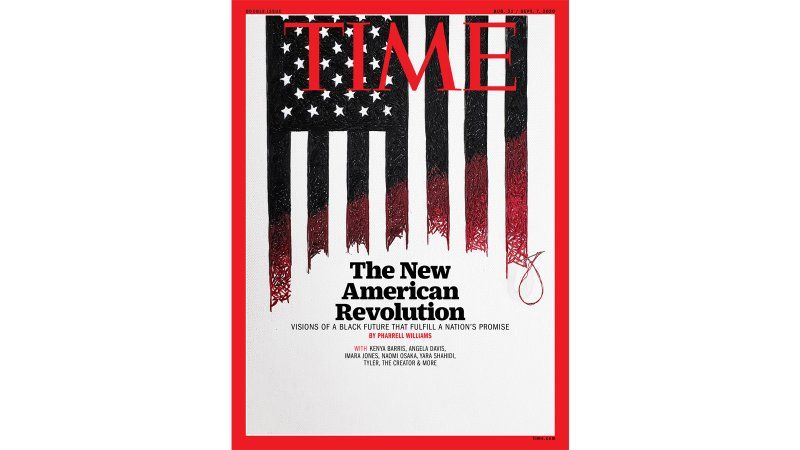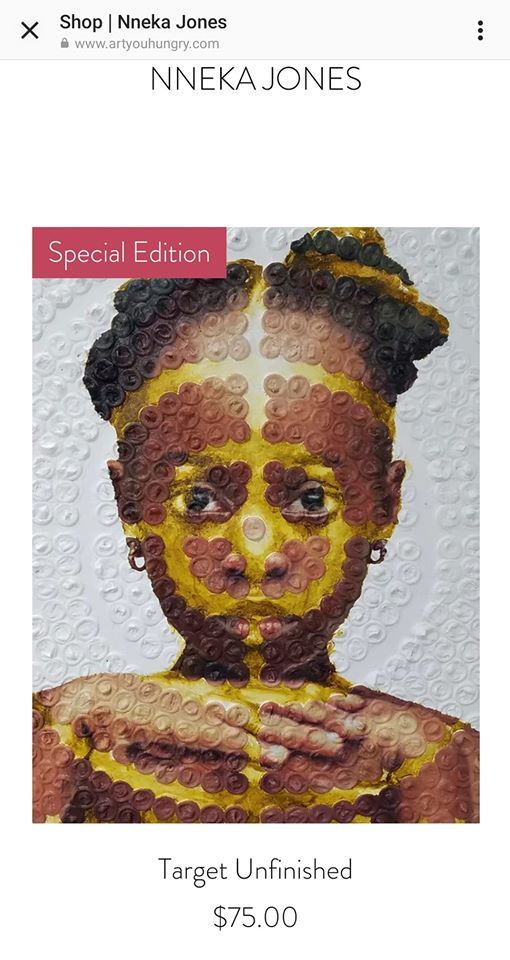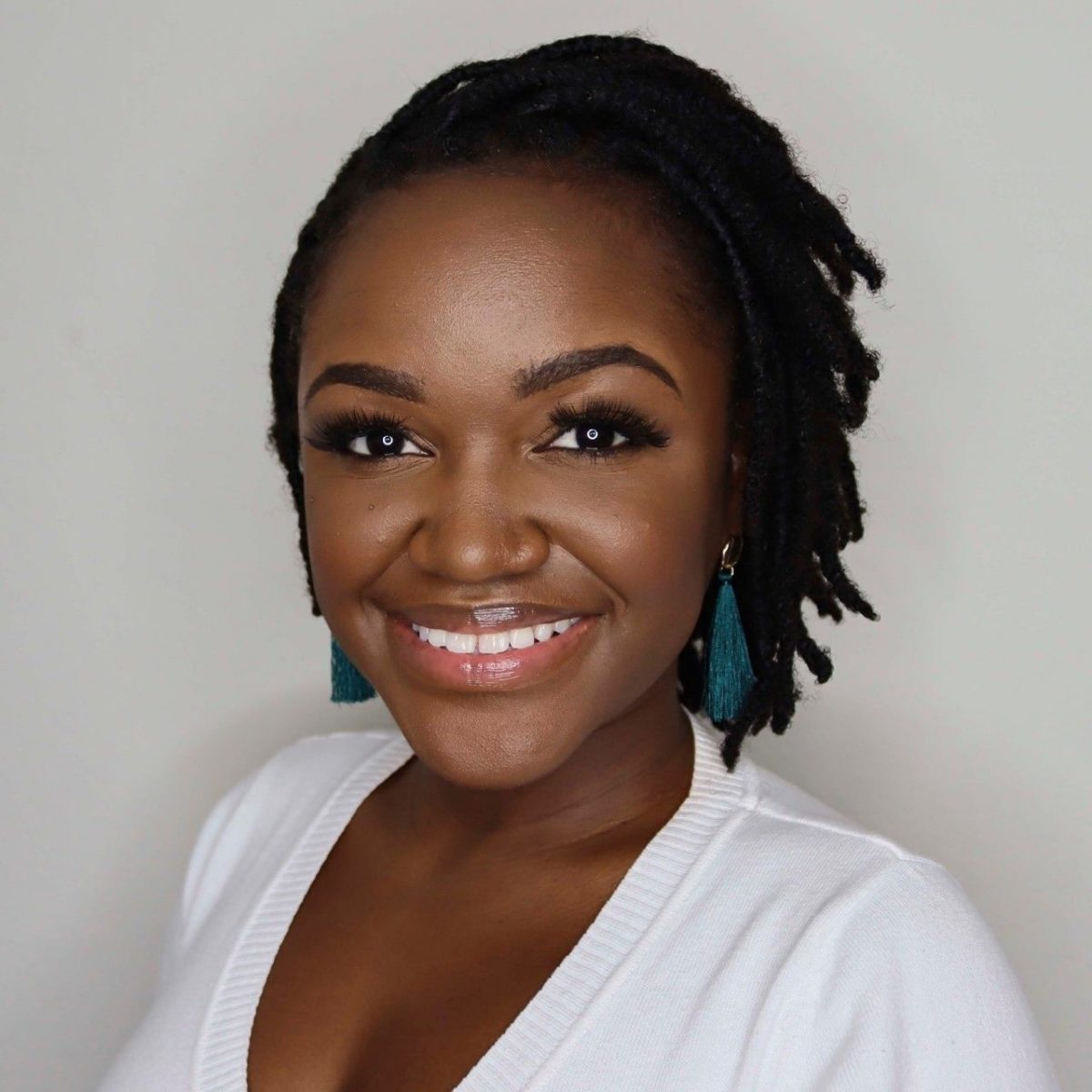(Trinidad Guardian) Twenty-three-year-old Nneka Jones, a recent graduate of the University of Tampa in Florida, is the latest T&T national to make the country proud as her unique artwork was selected by the long time eminent, American created, Time Magazine for its August 31 to September 7, issue.
Last Thursday a gloating Jones and founder of Art You Hungry took to her twitter page and tweeted: “Thank you @TIME and at @Pharrell for this amazing opportunity to produce the hand-embroidered cover artwork for this recent issue.”
Her stunning-yet controversial work of the American flag sets the tone for a series of conversations and essays focused on the fostering of a more unbiased and even-handed future for African-Americans. Four-time Grammy Award-winning recording artist and producer Pharrell Willams curated the series.

Time International Art Director Victor Williams sought Jones after stumbling on a picture on her Instagram page of her realistic artistic portrayal of murdered unarmed African-American George Floyd who was killed on May 24 in Minneapolis, Minnesota by white ex-police officer Derek Chauvin.
Guardian media spoke with the Jones who’s making the rounds doing interviews about her recent success and this is what she shared in Guardian Media’s questions and answers.
Question: Can you give us a little background about your time here in Trinidad?
JONES: I grew up in Port-of-Spain, Trinidad and also went to school at Newtown R.C. Girls’ and Bishop Anstey High School. These schools provided me with a solid foundation for the artistic journey I am on now. The Trinidadian culture was a strong influence on the content of my work at a very early age, particularly because we are a melting pot of different cultures and ethnicities. During my time at Bishop Anstey, my art teachers played a large role in the support and encouragement, especially during the stressful time of CSEC and CAPE Examinations. This resulted in my achievements of placing first in the Caribbean for visual art during my CSEC examinations and appearing on the Merit List twice for CAPE. I know now how important it is to cherish those assignments and long nights of work while at high school because it provided me with the independence and discipline to pursue a career as a full-time artist now and I am grateful to make my country proud on a global scale.
Question” How did your love affair with art began and did you think it would ever get to the place it is today?
Answer: I began making art from as early as age five-years-old but only started calling myself an artist at around age 12. My family, particularly my older sisters, would reminisce on the days that they would open their school notebooks and see that I had spent quite a few hours decorating their pages with scribbles and stick figures. So, for me, I believe this all started with my fascination with doodling and sketching, which then turned into a love for painting and sculpture.

Once I started referring to myself as an artist and developing my technical skills, I knew that I had high hopes for my future and would also dream of being a gallery owner and having multiple solo shows around the world. However, part of me had doubts due to the stereotypes of artists and the inability for most to sustain a long term career; but I was still determined to work against this stereotype.
Question: How would you describe the conversation of your artwork? What does it speak to and what inspires those conversations?
Answer: After graduating from the University of Tampa and reflecting on my body of work, I was able to confidently call myself an activist artist. This meant that I was not creating work simply for aesthetics but intending to communicate a specific message and evoke emotion. My work focuses on highlighting social and political injustices with hopes to create a shift towards more positive change, both in Trinidad and internationally.
This urge to create activist art comes from the existence and rise of issues such as sexual abuse, sex trafficking, colourism, racism and other important social issues in society today.
Question: It was your artistic portrayal of George Floyd that got the attention of Time Magzine. When you got the email from TIME, what was your first reaction? And describe what transpired in the following days up to the submittal of your piece?
Answer: Receiving an email from Time’s art director Victor Williams is not something that I would have ever expected, especially after just graduating from university. I could not believe that it was real and had to do some background research to ensure that he was who he said he was. I was excited once I realised that this was actually happening and was fully on board to develop a piece for the issue, especially with topics relating to equality and racism that exists in America. However, this was not just any piece of artwork, a lot of planning and time went into developing the image that resulted in only 24 hours left for me to complete the final hand-embroidered piece. This was the first hand-embroidered piece that I would create in less than a week but I was determined to get it done, pulling an “all-nighter” just like in high school and college.
Question: Can you tell us the meaning of that piece and the message it conveys?
Answer: The piece is a symbol of optimism and direct intention to reshape America for a better and brighter future. It speaks to all of the protests, marches, deaths, inequalities and racism that have been amplified over the past few months. The lower portion of the flag is intentionally left incomplete with the needle remaining in the canvas to remind us that this is a work in progress and that it takes time to reshape a nation, but it will and must be done.
Question: Would you describe this as your best work yet or the greatest opportunity you’ve had to date, in your art career?
Answer This is definitely one of the greatest milestones I have achieved thus far in my art career. I am so thankful that Time decided to choose me as there are many other amazing and established artists that they could have worked with. It gives me hope that I have chosen the right path and I am excited for the many other opportunities to come and to continue making my family and Trinidad and Tobago proud.
Question: You use the embroidery technique, why? Is this your signature technique? And what are some of the other techniques you practice?
Answer: I discovered embroidery through an experimental class at the University of Tampa. It was my unique way of creating a painting without using paint and I have stuck with this style ever since. It allows me to express myself in a very unique way and capture the essence of a person using different length and colours of embroidery thread. I also work in mixed media using oil and acrylic paint and other materials such as condoms on canvas.
Question: Where can your work be found?
Answer: My work is currently being displayed at the Tampa Museum of Art in Tampa, Florida. And can be viewed via my website artyouhungry.com and Instagram, Facebook and twitter @artyouhungry. These will update on upcoming exhibitions for the end of the year and 2021.
Question: If you were to paint the state of the world right now what would be the overarching conversation reflected on your canvas?
Answer: Painting the state of the world right now would require a composition that embodies reflection. Reflection on the chaos and turmoil that has occurred throughout history and in the present but with a lens that also reflects the hope and faith of creating change and how this is slowly transitioning to a more equal and stable world and community.
Question: In three words describe art and its relevance to life.
Answer: Raw, Intentional and Truthful!

